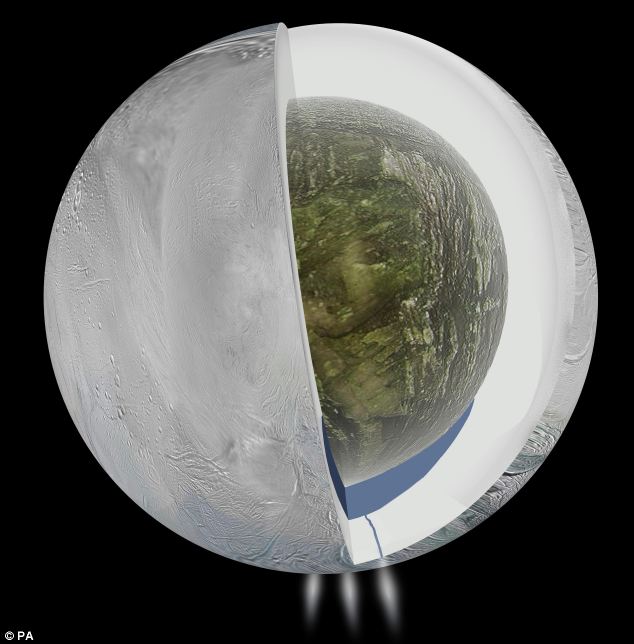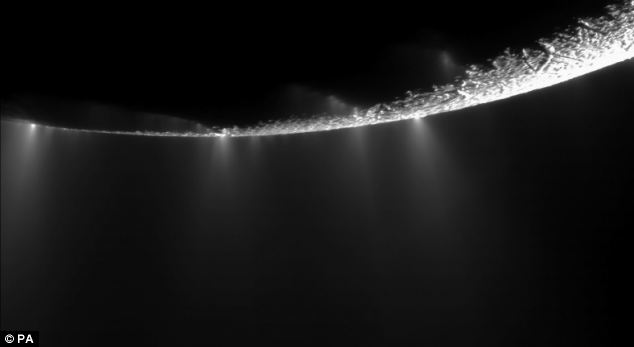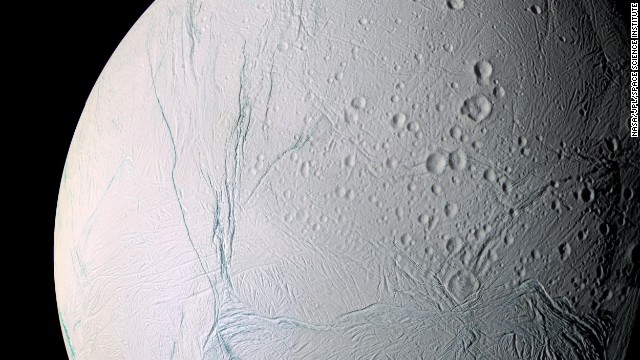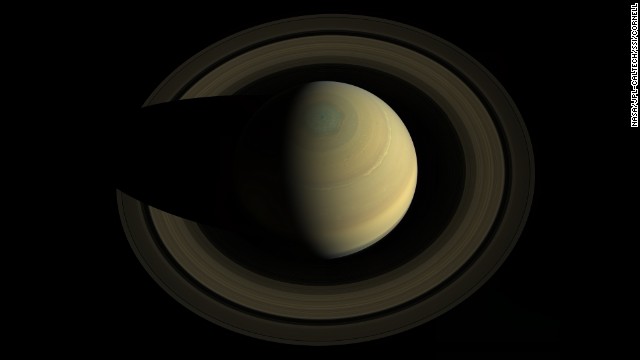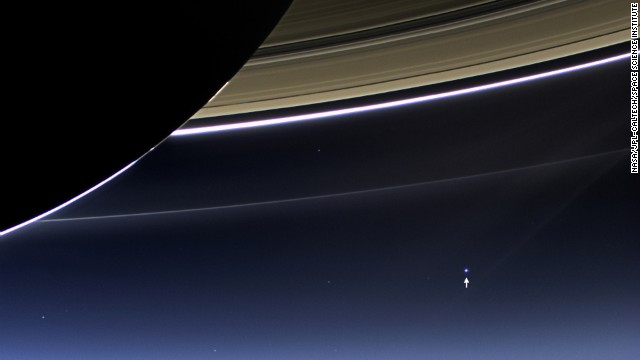There Is A Large Underground Ocean In One Of Saturn's Moons That Hints At Alien Life
One of the moons of Saturn has turned out to be another possible habitat for extraterrestrial microbes after scientists have discovered that it possesses a large ocean of water beneath its icy surface.
New data from NASA's Cassini spacecraft suggests that a lake at least the size of the world's second largest lake lies below a thick layer of ice on one of Saturn’s moon
An artistic illustration of Enceladus's hypothesised inner structure, showing the moon's 'geysers' spouting near its south pole, the thick sheet of ice that covers its surface, the subterranean lake that fuels the 'geysers' and a rocky core that somehow generates its own heat.
Image via dailymail.co.ukMeasurements of gravity fluctuations around Enceladus taken by Nasa’s Cassini spacecraft indicate that there is an underground ocean of melted water at the moon’s south pole which may be the source of dramatic vapour plumes seen at its surface.
cnn.comThe body of water is about the size of Lake Superior (560 km), the second largest lake on Earth (which is 16 times larger than Malaysia's Tasik Bera), and has a rocky bottom which could create conditions that allow tiny life forms to thrive.
thestar.com.myLake Superior has a volume of 12,000 cu km. The amount of liquid on Enceladus would be somewhat similar
Image via bbcimg.co.ukIn 2005, Cassini sent back astounding images of water vapour jetting from the surface of Enceladus
Jets of water vapour have previously been seen spouting from the southern polar region of Enceladus., leading scientists to predict that there is a deep watery reservoir beneath the moon's icy shell
Image via dailymail.co.ukThe jets were spouting from fractures in the frozen surface of the 300mile (483km) wide moon known as ‘tiger stripes’. Experts predicted that a large reservoir of underground water could be fuelling the plumes.
newschanneldaily.comThe results support earlier signs that this small moon has liquid water. That means Saturn's sixth-largest moon could have been or could now be hospitable to life.
The Saturn-facing side of Enceladus is illuminated by light bouncing off the planet. Plumes of water ice can be seen streaming off the moon's southern pole.
Image via turner.comThis discovery puts Enceladus in an exclusive club of extraterrestrial worlds in the solar system that appear to have a subsurface water ocean. The others are Titan, another moon of Saturn, and Europa, a moon of Jupiter. Callisto and Ganymede, also moons of Jupiter, may also have oceans under ice.
"As far as whether one should go first to Europa or Enceladus, I look at this as a kind of a cornucopia of habitable environments in the outer solar system," study co-author Jonathan Lunine of Cornell University said in a press conference Wednesday.
cnn.comResearchers believe the 560 km-wide moon’s lake is encased beneath a thick crust of crystal ice
“For the first time, we have used a geophysical method to determine the internal structure of Enceladus,” said co-author David Stevenson, professor of planetary science at Caltech. “This then provides one possible story to explain why water is gushing out of these fractures we see at the south pole.”
thestar.com.myThe Cassini mission is led by NASA, with the cooperation of the Italian Space Agency and European Space Agency. The spacecraft was launched 2004 and has visited all of Saturn’s largest moons. The sixth planet from the Sun, Saturn is characterised by its unusual rings and has 53 known moons and nine provisional moons.
newschanneldaily.comSo, what do scientists think is there?
The north pole of Enceladus has a thickness of ice around 30 miles, with solid rock beneath it. But at the south pole, there may be only 18 to 24 miles of ice covering a subsurface ocean that itself is 5 to 10 miles deep. This ocean appears to be a "lens-shaped reservoir" that's deepest at the south pole and thinner further afield. The ocean appears to sit on top of a rocky core and "may extend halfway or more towards the equator in every direction," said study co-author David Stevenson, professor of planetary science at California Institute of Technology, in a press conference.
cnn.comAlso noteworthy is that the north pole is heavily cratered, while the ice on the south pole is smoother, meaning it has been resurfaced and softened. Measurements from the new study and previous Cassini data suggest the moon's south pole has an ice layer on top of water on top of silicate rock. If that's true, water circulating through the rock would pick up elements such as phosphorous, sulfur, potassium and sodium into the liquid. These elements are essential for making molecules that life needs, Lunine said.
With respect to the ocean being on top of rock, the gravity data from Enceladus "makes the base of the ocean very much like the base of our own ocean on the Earth," Lunine said at the press conference. Enceladus is a small moon, with a diameter of only about 310 miles. In 2005, Cassini found that fractures called "tiger stripes" in the south polar region emit water vapor jets rich in salt, lead author Luciano Iess of Sapienza Università di Roma in Rome, Italy, said in a press conference Wednesday. Cassini has also detected organic molecules, which can come from biological or nonbiological sources, near the tiger stripes and in dust grains in the region.
cnn.comWhen no one has actually gone to Enceladus and seen this ocean under the thick ice, how then do scientists know what is there?
The scars of time and space mark the surface of Saturn's moon Enceladus. Saturn has at least 62 moons in its orbit.
Image via turner.comBecause scientists have strong evidence that it is there, based on gravity measurements made with Cassini. When the spacecraft flies by Enceladus, the gravity of the moon changes the probe's speed. Scientists can measure those changes back on Earth by detecting fluctuations in the frequency of the signal that Cassini sends back. If the spacecraft's speed doesn't change, the frequency would remain the same.
But depending on where Cassini flies, the frequency of the signal changes in particular ways. This allows scientists to learn more about the moon's subsurface features. Scientists had already known about the presence of a depression or "dimple" at the south pole of Enceladus, "as if there is some amount of, effectively, missing material," Lunine said. But in this new study, the change in gravity associated with the depression was not as dramatic as expected.
cnn.com"There must be some higher density layer that's underneath the ice, and that has to be a liquid water ocean, because there's really nothing else plausible that can explain that offset to what we would expect for the gravity signature of this depression," he said. It is possible that this ocean has been sending out the plumes that Cassini first observed in 2005, but this has not been verified.
newschanneldaily.comHow can we look for signs of life there?
NASA's Cassini spacecraft glided high above Saturn in October to capture this 36-image mosaic of the ringed planet. The colors of the planet appear natural, just as the human eye would see them
Image via turner.comSending a probe to Enceladus with a drill wouldn't be entirely practical because the liquid water is so far under the ice that it would be hard to access, Lunine said. Instead, a spacecraft with instruments more sophisticated than Cassini could fly through the plumes of material being ejected from fractures in the ice. Cassini has already detected the water vapor and organic molecules in these plumes, using a device called a mass spectrometer.
But a more advanced, more sensitive version of the same instrument could better test for the "menu of molecules" associated with an advanced biological system, Lunine said. Detecting these molecules could be "the smoking gun for whether in fact there is life down there or not," he said.
cnn.comFun fact: The small bright dot seen in the bottom right is not another Saturn moon. It's Earth.
"The distance between Saturn and our planet is constantly changing because both are constantly in motion. When they are closest together during their orbits, Saturn is 746 million miles away from Earth. At its farthest, they are just over a billion miles apart."
cnn.com